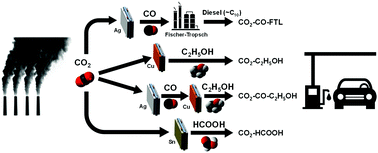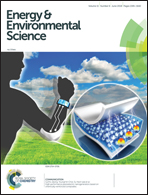A comparative technoeconomic analysis of pathways for commercial electrochemical CO2 reduction to liquid products†
Abstract
Electrochemical reduction of CO2 to fuels and chemicals is currently a focus of significant research effort as a technology that can simultaneously mitigate greenhouse gas emissions while storing renewable electricity for use on demand. Liquid products are particularly desirable as an easily storable and portable energy-dense form. To be widely implemented, CO2 electroreduction technologies must be able to produce chemicals at costs that are economically competitive with existing commercial prices. In this work, four possible routes to the electrochemical synthesis of liquid products from CO2 derived from post-combustion flue gas were compared with one consistent approach to technoeconomic analysis. In the first case, diesel fuel was produced from electrosynthesized CO plus H2 to make syngas which was subsequently converted through the Fischer–Tropsch process. Liquid ethanol was modeled through two comparable approaches, a one-step electrolysis and a two-step cascade electrolysis. Lastly, the direct electrosynthesis of formic acid from CO2 was considered. In the base case scenarios established on current state-of-the-art CO2 reduction research, none of the processes were modeled to be competitive with present fuel prices. High capital expense for the electrolyzer units was the primary limiting factor. With conceivable improvements in an optimistic scenario, the diesel process was projected to have the best pathway to making cost-effective fuels, while ethanol would be prohibitively expensive without major improvements to the present electrosynthesis performance. Formic acid, though projected to be expensive relative to its stored energy content, was projected to have perhaps the simplest pathway to production at costs competitive with its commercial bulk price. In each case, the levelized cost of the liquid product was most strongly influenced by parameters that affect the electrolyzer capital cost (i.e., current density, faradaic efficiency, and cost per electrode area).



 Please wait while we load your content...
Please wait while we load your content...